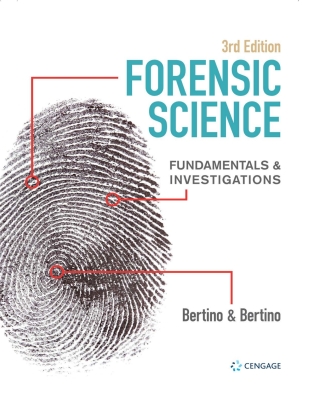Buy Forensic Science: Fundamentals & Investigations, 3rd Edition PDF ebook by author Anthony J. Bertino; Patricia Bertino – published by Cengage Learning in 2021 and save up to 80% compared to the print version of this textbook. With PDF version of this textbook, not only save you money, you can also highlight, add text, underline add post-it notes, bookmarks to pages, instantly search for the major terms or chapter titles, etc.
You can search our site for other versions of the Forensic Science: Fundamentals & Investigations, 3rd Edition PDF ebook. You can also search for others PDF ebooks from publisher Cengage Learning, as well as from your favorite authors. We have thousands of online textbooks and course materials (mostly in PDF) that you can download immediately after purchase.
Note: e-textBooks do not come with access codes, CDs/DVDs, workbooks, and other supplemental items.
eBook Details:
Full title: Forensic Science: Fundamentals & Investigations, 3rd Edition
Edition: 3rd
Copyright year: 2021
Publisher: Cengage Learning
Author: Anthony J. Bertino; Patricia Bertino
ISBN: 9780357361788, 9780357361788
Format: PDF
Description of Forensic Science: Fundamentals & Investigations, 3rd Edition:
With popular television programs, movies, and books about criminal justice and crime scene investigation, students often have a passion for exploring forensic science. Now that excitement can be guided into valuable learning experiences with the help of Forensic Science: Fundamentals & Investigations, 3e. This dynamic, visually powerful text has been carefully crafted to ensure solid scientific content and an approach that delivers precisely what is needed for high school courses. Now an established best-seller, Forensic Science: Fundamentals & Investigations offers a truly experiential approach that engages students in active learning and emphasizes the application of integrated science. Student materials combine math, chemistry, biology, physics, and earth science with content aligned to the Next Generation Science Standards. Capstone projects integrate the concepts learned throughout the text. Comprehensive, time-saving teacher support and lab activities deliver exactly what is needed to ensure that students receive a solid, integrated science education that keeps readers engaged at all learning levels. Supported by MindTap with an eBook, online assessments, Interactive Labs, and Virtual Labs, students learn content and practice skills like real forensic scientists.Important Notice: Media content referenced within the product description or the product text may not be available in the ebook version.
Table of Contents of Forensic Science: Fundamentals & Investigations, 3rd Edition PDF ebook:
PrefaceBrief ContentsContentsChapter 1: Forensic Science and ObservationIntroductionWhat Is Forensic Science?What Do Forensic Scientists Do?Observation and PerceptionEyewitness ObservationImproving Observation SkillsInterview TechniquesSummaryCase StudiesCareers in Forensics: Dr. Paul EkmanChapter 1 ReviewActivity 1-1: Learning to SeeActivity 1-2: You Are an Eyewitness!Activity 1-3: What Influences Our Observations?Chapter 2: Crime-Scene Investigation and Evidence CollectionIntroductionCrime-Scene InvestigationThe Crime-Scene Investigation TeamLocard’s Principle of ExchangeTypes of EvidenceThe Seven S’s of Crime-Scene InvestigationMapping the Outdoor Crime SceneAnalyzing the EvidenceStaged Crime ScenesAdvances in Crime-Scene InvestigationSummaryCase StudiesCareers in Forensics: Carl WilliamsChapter 2 ReviewActivity 2-1: Locard’s Principle of ExchangeActivity 2-2: Crime-Scene InvestigationChapter 3: Hair AnalysisIntroductionHair as EvidenceHistory of Hair AnalysisThe Science of Hair AnalysisCharacteristics of HairNonhuman and Human HairCollecting Hair Evidence in an InvestigationForensic Analysis of HairAdvances in Hair AnalysisSummaryCase StudiesCareers in Forensics: Dr. William J. WalshChapter 3 ReviewActivity 3-1: Trace Evidence: HairActivity 3-2: Hair MeasurementActivity 3-3: Hair Testimony EssayChapter 4: Fiber AnalysisIntroductionFiber as EvidenceHistory of FibersThe Science of FibersCharacteristics of Fibers, Yarns, and TextilesCollection of Fiber in an InvestigationAnalyzing Fiber EvidenceEvaluating the Value of Fiber EvidenceAdvances in Fiber AnalysisSummaryCase StudiesCareers in Forensics: Dr. Irene GoodChapter 4 ReviewActivity 4-1: Microscopic Fiber AnalysisActivity 4-2: Bedsheet Thread CountActivity 4-3: Weave Pattern AnalysisActivity 4-4: Textile IdentificationActivity 4-5: Burn Analysis of FibersChapter 5: Forensic BotanyIntroductionForensic BotanyHistory of Forensic BotanyThe Science of Forensic BotanyCharacteristics of Botanical EvidenceDocumenting, Mapping, Collecting, and Packaging EvidenceAnalyzing Botanical EvidenceAdvances in Forensic BotanySummaryCase StudiesCareers in Forensics: Dr. Lynne MilneChapter 5 ReviewActivity 5-1: Comparing Suspect Pollen to Crime-Scene PollenActivity 5-2: Pollen Expert Witness PresentationActivity 5-3: Botanical Evidence Case Studies PresentationActivity 5-4: Processing a Crime Scene for Botanical EvidenceActivity 5-5: Pollen IndexActivity 5-6: Isolation of Pollen from HoneyChapter 6: FingerprintsIntroductionThe History of FingerprintingThe Science of FingerprintsCharacteristics of FingerprintsCollection and Documentation of FingerprintsForensic Analysis of FingerprintingAdvances in FingerprintingSummaryCase StudiesCareers in Forensics: Peter Paul BiroChapter 6 ReviewActivity 6-1: Study Your FingerprintsActivity 6-2: Giant Balloon FingerprintActivity 6-3: Studying Latent and Plastic FingerprintsActivity 6-4: How to Print a Ten CardActivity 6-5: Minutiae PatternsActivity 6-6: Fingerprint AnalysisActivity 6-7: Using Cyanoacrylate to Recover Latent FingerprintsChapter 7: DNA ProfilingIntroductionWhat Is DNA Profiling?History of DNA ProfilingThe Science of DNACharacteristics of DNA ProfilingCollection and Preservation of DNA EvidenceDNA Profiling AnalysisAdvances in DNA ProfilingSummaryCase StudiesCareers in Forensics: Dr. Kary Banks MullisChapter 7 ReviewActivity 7-1: Simple DNA ExtractionActivity 7-2: The Break-InActivity 7-3: Anna Anderson or Anastasia? STR AnalysisActivity 7-4: STR Identification of a September VictimActivity 7-5: Identification of the Romanovs Using STR ProfilingChapter 8: Blood and Blood SpatterIntroductionHistory of Forensic Blood AnalysisThe Science of BloodCharacteristics of Blood EvidenceInvestigating Blood Evidence at the Crime SceneAnalyzing Blood EvidenceAdvances in Blood AnalysisSummaryCase StudiesCareers in Forensics: T. Paulette SuttonChapter 8 ReviewActivity 8-1: A Presumptive Test for BloodActivity 8-2: Creating and Modeling Blood-Spatter PatternsActivity 8-3: Blood-Spatter Analysis: Effect of Height on Blood DropsActivity 8-4: Area of ConvergenceActivity 8-5: Blood-Droplet Impact AngleActivity 8-6: Area of OriginActivity 8-7: Crime-Scene InvestigationChapter 9: Forensic ToxicologyIntroductionToxicologyHistory of Forensic ToxicologyThe Science of ToxicologyCharacteristics of Poisons, Toxins, and DrugsProcessing EvidenceForensic Analysis of Poisons, Toxins, and DrugsAdvances in Forensic ToxicologySummaryCase StudiesCareers in Forensics: Dr. Don CatlinChapter 9 ReviewActivity 9-1: Drug AnalysisActivity 9-2: Should Medical Marijuana Be Legalized in All StatesActivity 9-3: Drug Spot TestChapter 10: Handwriting Analysis, Forgery, and CounterfeitingIntroductionDocument AnalysisHistory of Forensic Handwriting AnalysisThe Science of HandwritingCharacteristics of HandwritingForensic Analysis of HandwritingForgeryCounterfeitingAdvances in Analysis, Detection, and PreventionSummaryCase StudiesCareers in Forensics: Lloyd CunninghamChapter 10 ReviewActivity 10-1: Handwriting AnalysisActivity 10-2: Analysis of a Ransom Note and Report to JuryActivity 10-3: Examination of U.S. Currency: Is It Authentic or CounterfeitChapter 11: Forensic EntomologyIntroductionForensic EntomologyHistory of Forensic EntomologyThe Science of Forensic Entomology: Insects and DecompositionCharacteristics of Forensic EntomologyProcessing a Crime Scene for Insect EvidenceAnalysis of Insect EvidenceAdvances in Forensic EntomologySummaryCase StudiesCareers in Forensics: Dr. Neal HaskellChapter 11 ReviewActivity 11-1: How to Raise Blowflies for Forensic EntomologyActivity 11-2: Mini Projects for Forensic EntomologyActivity 11-3: Observation of Blowflies or HousefliesActivity 11-4: Factors Affecting Postmortem Interval Estimates and ADHChapter 12: Death: Manner, Mechanism, CauseIntroductionThe Importance of Examining DeathHistory of Death ExaminationsThe Science of Death ExaminationsCharacteristics of DeathStages of DecompositionDeath-Scene InvestigationsForensic Analysis of DeathAdvances in Death InvestigationsSummaryCase StudiesCareers in Forensics: Dr. Michael BadenChapter 12 ReviewActivity 12-1: Calculating PMI Using Rigor MortisActivity 12-2: Calculating PMI Using Algor MortisActivity 12-3: Tommy the TubActivity 12-4: Analysis of Evidence from Death ScenesChapter 13: Soil EvidenceIntroductionSoil as EvidenceHistory of Forensic Soil ExaminationThe Science of SoilCharacteristics of SandPhotographing, Documenting, Collecting, and Packaging Soil EvidenceAnalysis of Soil EvidenceAdvances in the Detection and Analysis of Soil EvidenceSummaryCase StudiesCareers in Forensics: Dr. Rob FitzpatrickChapter 13 ReviewActivity 13-1: Sand ObservationActivity 13-2: Sorting of Sand Using Sieve PlatesActivity 13-3: Sorting of Sand by Size and ShapeActivity 13-4: Examination of Sand and Mineral PercentagesActivity 13-5: Chemical and Physical Analysis of SandActivity 13-6: Soil Evidence ExaminationChapter 14: Forensic AnthropologyIntroductionThe Importance of Forensic AnthropologyHistory of Forensic AnthropologyThe Science of BoneCharacteristics of BonesThe Search, Collection, and Documentation of Skeletal RemainsAnalysis of Skeletal RemainsAdvances in Forensic AnthropologySummaryCase StudiesCareers in Forensics: Dr. Clyde SnowChapter 14 ReviewActivity 14-1: Determining the Age of a SkullActivity 14-2: Bones: Male or Female?Activity 14-3: Identifying the Romanovs-An Internet ActivityActivity 14-4: Estimation of Body Size from Individual BonesActivity 14-5: What Bones Tell UsActivity 14-6: Height and Body ProportionsChapter 15: Glass EvidenceIntroductionThe Importance of Glass EvidenceThe History of GlassThe Science of GlassCharacteristics of GlassCollecting and Documenting Glass EvidenceAnalysis of Glass EvidenceAdvances in Glass Production and AnalysisSummaryCase StudiesCareers in Forensics: David GreenChapter 15 ReviewActivity 15-1: Glass Fracture Pattern AnalysisActivity 15-2: Glass DensityActivity 15-3: Approximating the Refractive Index of Glass Using a Submersion TestActivity 15-4: Determining the Refractive Index of Liquids Using Snell’s LawChapter 16: Casts and ImpressionsIntroductionImpressions as EvidenceHistory of Impression EvidenceFormation of Impression EvidenceShoe and Foot ImpressionsTire and Tread ImpressionsDental ImpressionsAdvances in Analyzing Impression EvidenceSummaryCase StudiesCareers in Forensics: Dr. Thomas NoguchiChapter 16 ReviewActivity 16-1: Making a Plaster of Paris CastActivity 16-2: Shoe Size, Foot Size, and HeightActivity 16-3: Tire Impressions and AnalysisActivity 16-4: Vehicle IdentificationActivity 16-5: Dental ImpressionsChapter 17: Tool MarksIntroductionTool Marks as EvidenceHistory of Tool Mark AnalysisThe Science behind Tool Mark AnalysisCharacteristics of Tools and Tool Mark ImpressionsDocumenting, Collecting, and Preserving Tool Mark EvidenceAnalyzing Tool Mark EvidenceAdvances in Tool Mark AnalysisSummaryCase StudiesCareers in Forensics: Dr. David P. BaldwinChapter 17 ReviewActivity 17-1: Tool Marks: Screwdrivers and ChiselsActivity 17-2: Hammers and Hammer ImpressionsActivity 17-3: Casting Impressions of Hammer Strikes on Wood in SiliconeChapter 18: Firearms and BallisticsIntroductionBallistic EvidenceHistory of Gunpowder and FirearmsThe Science of BallisticsCharacteristics of Firearms and ProjectilesCollection and Documentation of Ballistic EvidenceAnalysis of Firearm and Ballistic EvidenceAdvances in Ballistic AnalysisSummaryCase StudiesCareers in Forensics: Gregory KleesChapter 18 ReviewActivity 18-1: Bullet TrajectoryActivity 18-2: Firing Pin AnalysisActivity 18-3: Describing Spent ProjectilesActivity 18-4: How Good Is Your Aim?Capstone ProjectsProject 1: Physical Evidence Case StudiesProject 2: Personal Evidence PortfolioProject 3: How Reliable Is the Evidence?Project 4: Landmark Cases in Acceptance of EvidenceProject 5: Analysis of a Forensic Science Movie or TV Show EpisodeProject 6: Forensic Dumpster Diving-What Garbage Can Tell UsProject 7: Forensic Science Career ExplorationProject 8: Crime-Scene Development and ProcessingProject 9: How to Read CalipersProject 10: Gravesite ExcavationGlossary/GlosarioAppendix A: Table of SinesAppendix B: Table of TangentsAppendix C: Celsius-Fahrenheit Conversion TableIndex





